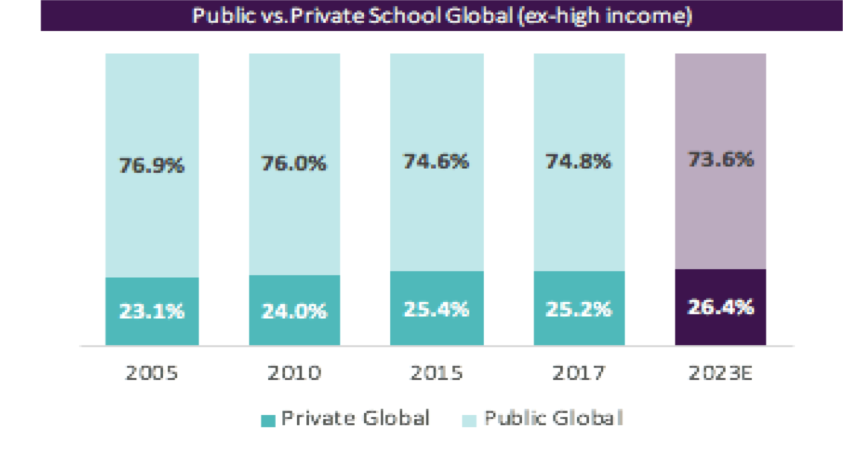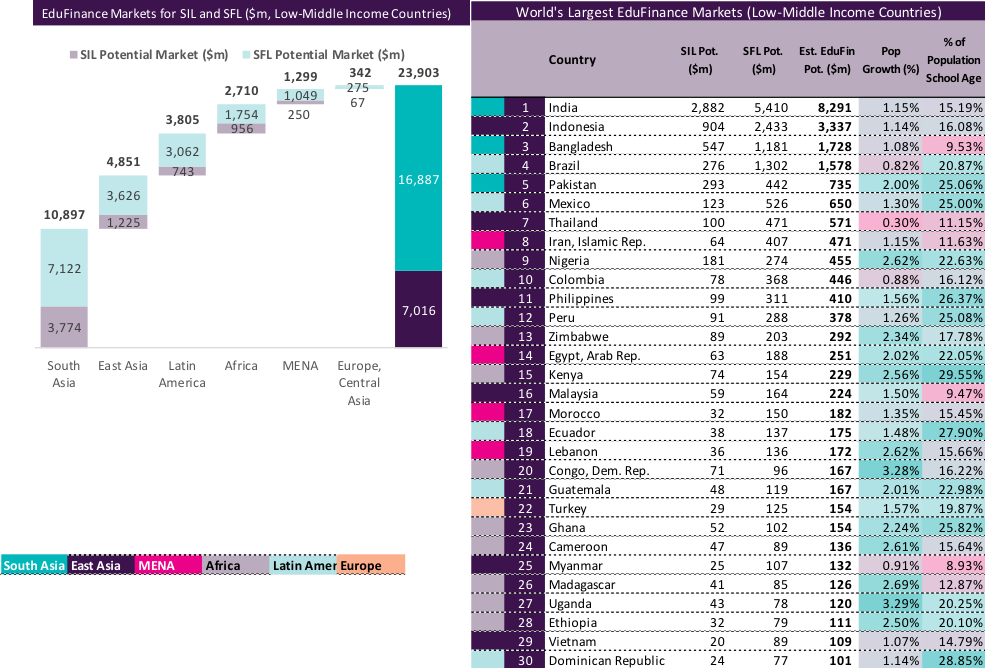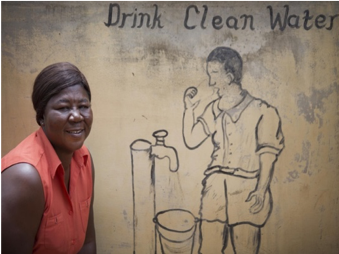The $24 Billion Opportunity
Education is essential for the economic and social growth of individuals and society, and its benefits are far-reaching and well-documented. For the individual, education enhances people’s ability to achieve higher earnings, live healthier lives, make more informed decisions and exercise their rights. For societies, education can improve social cohesion, foster innovation, promote economic growth and reduce poverty1.
Despite global gains in education and a global drive towards UN adopted Sustainable Development Goal number four (4) - ‘to ensure inclusive and equitable quality education and promote lifelong learning opportunities for all’2 – access to quality education remains far from a universal reality in 2019. For many children in low and middle -income countries, access to quality education remains scarce. To put things into perspective…
- 263 million, 1 in 5, school age children globally are not in school3 .
- 617 million children are not learning whilst in school4.
- 800 new schools per day, for the next five years, would need to be built to cater for all out-of-school children. See Figure 1.
- Over half of school-age population growth will occur in Africa up to 20505.
Within these findings however, there is opportunity. There is a rapidly expanding segment of the global education sector that is successfully engaging more children in low- and middle-income countries in good quality “Affordable Private Schools” (APSs).
Figure 1. Low & Middle Income Countries - # of School Seats Required

A recent report ‘The $24 Billion Opportunity: A case for increasing private schools’ access to finance in low- and middle-income countries’ produced by Opportunity International’s EduFinance team, sheds light on the potential to get more kids into quality schools via the APS sector. The private school sector has expanded to 24% of all schools in low-and middle- income countries in response to the gap in provision (See Figure 2). With student enrolment expanding so rapidly, ever increasing demand makes access to finance an essential ingredient for schools to improve the quality of their facilities and services. The report estimates the potential market opportunity to lend to these schools at $24 billion (See Figure 3).
Figure 2. Global Estimates of Public vs Private School Coverage

Figure 3. Estimated EduFinance market demand

EduFinance has worked with financial institution partners in Africa, Asia and Latin America to develop and offer financing to the APS sector via School Improvement Loans (SILs) and families with school-aged children via School Fee Loans (SFLs). Demand for technical assistance from potential financial institution partners continues to grow globally.
The report utilized EduFinance’s unique position in the APS market in low- and middle-income countries to conduct a sizing analysis. Triangulating field research with publicly available data from the UNESCO Institute of Statistics (UIS), the World Bank Open Data Initiative, and the Education Policy Data Center (EPDC), the team developed a model to estimate the number of private schools and the demand for financing them. Data was collected on demographic trends, government expenditure, market demand as well as surveys and market research that had already been conducted for the SIL and SFL products. As Figure 4 shows, the number of children in APSs is currently around 300 million and expanding at a rate of 16%.
Figure 4. Private education growing much faster than public education in low and middle-income markets

Scott Sheridan, Director of Operations, EduFinance explains:
“This report highlights the relevance of the affordable private school sector in addressing the global education crisis. It demonstrates that there is a part to be played by all if we are not only planning to reach children currently out of school but build infrastructure and capacity necessary to get more kids in better schools.”
In the context of growing unmet demand for education and capacity-constrained public management, states are being encouraged to recognize the value that non-governmental actors, including the private sector, can bring to education6. The majority of private schools in developing regions adopt a small, low-cost model, enabling access to low-income families. Indeed, these schools are often end up costing similar amounts to public schools when accounting for informal fees. APSs fill the gaps where the nearest public schools are too far away, or where demand for public school seats exceeds supply.
The importance of these findings is clearly the potential to change the lives of individuals and their communities where access to quality education is scarce. The global EduFinance team experiences these transformations first hand. Erika’s story illustrates this.
Unable to access public education in her local community of Adansi, the Ashanti region of Southern Ghana, Erika was without other options. The long distance to the nearest public school that regularly had no spare seats for new students led to high drop-out rates in the region.

However, Erika was given the opportunity to study when local entrepreneur and teacher, Beatrice Sarkodie, built a nearby private school. Once established and ready for expansion, Beatrice was able to access a SIL from an Opportunity International partner financial institution. The loan had unique terms designed specifically for school owners seeking to invest in their affordable private schools and making repayments aligned with the school term fee collection schedule.
Stories like Erika and Beatrice’s highlight the important role the currentlyunder-leveraged APS sector can play in closing the education gap across low- and middle-income countries. At present, its growth has largely been financed organically – by proprietors’ savings or informal borrowing. Because low-cost private schools are heavily dependent on tuition from low-middle income families, commercial banks and other lending institutions often consider them too risky and are unwilling to extend lines of credit7. In addition, while low-cost schools keep their fees low to attract lower-income families in the surrounding communities, these same families do not always have the steady cash flow readily available to pay for school costs. These families can benefit from SFLs, which help to smooth cash flows and ensure that their children do not miss out on the first few weeks of the term and fall behind.
The opportunity is clear. The case has been made for financial institutions to do what they do best and recognise the opportunity to invest in this expanding market which offers a solution to help close the education gap. EduFinance financial partners across 20 countries have risen to this challenge and are leading the growth path. In 2019, these partnerships will become deeper and wider as the organization builds on active relationships and reaches into new countries, having a broader child impact.
Click here to learn more about EduFinance
1 World Bank (2018). “Learning to Realize Education’s Promise”. World Development Report. Available at:
http://www.worldbank.org/en/publication/wdr2018
2 UNESCO (2019). Global Education Monitoring Report. Available at: https://en.unesco.org/gem-report/sdg-goal-4.
3 UNESCO Institute for Statistics (UIS) and Global Education Monitoring Report (GEMR) (2016). “Leaving No One Behind: How Far on the Way to Universal Primary and Secondary Education?” GEMR policy paper 27/UIS fact sheet No. 37. Montreal and Paris: UIS and GEMR. Available at: http://unesdoc.unesco.org/images/0024/002452/245238E.pdf
4 UNESCO Institute for Statistics (UIS) (2017). “More than One-Half of Children and Adolescents are Not Learning Worldwide.” UIS fact sheet No. 46.Montreal: UI. Available at: http://uis.unesco.org/sites/default/files/documents/fs46-more-than-half-children-not-learning-en- 2017.pdf
5 United Nations Department of Economic and Social Affairs (2017). World Population Prospects: The 2017 Revision – Key Findings and Advance Tables. Available at: https://esa.un.org/unpd/wpp/Publications/Files/WPP2017_KeyFindings.pdf
6 Heyneman, S., Stern, J., Smith, T. (2011) “The Search for Effective EFA Policies: The Role of Private Schools for Low-Income Children.” United States Agency for International Development (USAID).
7Ibid